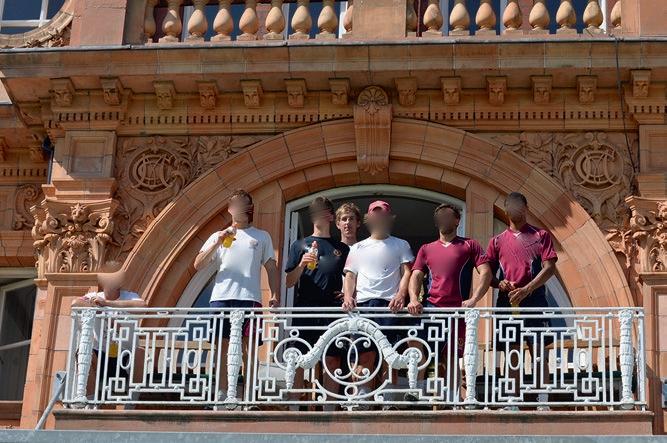University Cricket and Emerging Adulthood 1st ed. Edition Harry C. R. Bowles
Visit to download the full and correct content document: https://ebookmass.com/product/university-cricket-and-emerging-adulthood-1st-ed-edit ion-harry-c-r-bowles/








Visit to download the full and correct content document: https://ebookmass.com/product/university-cricket-and-emerging-adulthood-1st-ed-edit ion-harry-c-r-bowles/










 Harry C. R. Bowles
Harry C. R. Bowles


“University Cricket and Emerging Adulthood provides an excellent insight into the everyday lives of young adults as they attempt to negotiate their way towards, or transition away from, a career in professional cricket. The book is an important read for those seeking to gain a critical understanding, and in-depth exposition, of identity construction as it relates to the life chances and choices of young individuals seeking to make sense of their occupational journey. This richly informative and evocative study translates beyond the realm of sport, offering a strong conceptual anchoring to the theoretical appreciation of identity work. Drawing upon a blend of social theory and ethnographic empiricism, in its most honest form, the book is an indispensable work that uncovers the consequences of those who are investing their lives into the uncertain and precarious world that embodies professional sport.”
—Dr Andrew Manley, Lecturer at University of Bath, UK
“This text offers a compelling read and an excellent insight into the world of elite university cricket and the ‘lifestyle’ it creates for its participants. All ethnographies are enshrined in time and location—after all, they reflect stories from a specific time and place—but some present timeless accounts that cross the contextual barriers of sport and continue to resonate with the reader long after reading. Whether you are a sociologist, social psychologist, coach or simply a cricket lover, this book will intrigue and engage you. Throughout, Harry Bowles shines a warm and empathetic light on the occasionally cold, closeted side of cricketing life and captures the human side of his participants’ stories, while delivering a frank dose of realism to those ‘chasing the dream’.”
—Dr Chris Wagstaff, Practitioner Psychologist and Principal Lecturer in Performance Psychology at University of PortsmouthHarry C. R. Bowles Cyncoed Campus
Cardiff Metropolitan University Cardiff, UK
ISBN 978-3-319-76281-4
ISBN 978-3-319-76282-1 (eBook)
https://doi.org/10.1007/978-3-319-76282-1
Library of Congress Control Number: 2018936341
© The Editor(s) (if applicable) and The Author(s) 2018
This work is subject to copyright. All rights are solely and exclusively licensed by the Publisher, whether the whole or part of the material is concerned, specifically the rights of translation, reprinting, reuse of illustrations, recitation, broadcasting, reproduction on microfilms or in any other physical way, and transmission or information storage and retrieval, electronic adaptation, computer software, or by similar or dissimilar methodology now known or hereafter developed.
The use of general descriptive names, registered names, trademarks, service marks, etc. in this publication does not imply, even in the absence of a specific statement, that such names are exempt from the relevant protective laws and regulations and therefore free for general use.
The publisher, the authors and the editors are safe to assume that the advice and information in this book are believed to be true and accurate at the date of publication. Neither the publisher nor the authors or the editors give a warranty, express or implied, with respect to the material contained herein or for any errors or omissions that may have been made. The publisher remains neutral with regard to jurisdictional claims in published maps and institutional affiliations.
Cover credit: Nil Raths / EyeEm / Getty Images
Printed on acid-free paper
This Palgrave Macmillan imprint is published by Springer Nature
The registered company is Springer International Publishing AG
The registered company address is: Gewerbestrasse 11, 6330 Cham, Switzerland
There are many types of studies undertaken by PhD students. Some are prescriptive and formulaic. Others are more free-form where the student sets out on a kind of academic expedition largely unaware of where their intellectual journey will take them. These latter projects are not trying to prove or disprove anything. Rather, they are personal explorations of the unique dialectic between researcher and researched and the melee of activity in between.
It would be fair to say that the period since the 1970s has witnessed the emergence of a body of knowledge around the social and cultural aspects of sport whereby qualitative research methods and methodologies have become a staple in the field. Yet relatively few social researchers have managed to breach the institutional bounds of elite sport and fewer still have carried out in-depth qualitative work within cricketing contexts. For all the modern-day media coverage that it commands, elite sport remains a heavily guarded affair, particularly in terms of who and what gains access to its inner sanctums. The truth is, ethnographies of sport are hard to find—and good ones are even harder. Here we are in luck.
In July 2014 I had the privilege of examining Harry Bowles’ PhD thesis—upon which this book is based. I knew from the moment that I started to read Harry’s work that I was going to find out as much about him as I was about his research. One of the hallmarks of ethnographic craft is its deployment of empathy and sensitivity and, as you are about
to discover, this work is replete with both. Seldom have I enjoyed reading a PhD so much. Rarely have I met a beginning scholar with such an innate sense of how to make the familiar strange. Indeed, one of the things that impresses me the most about Harry’s work is his ability to tell an accessible and engaging story whilst at the same time maintaining the level of academic rigour expected within the ethnographic tradition.
For anyone even remotely involved with or interested in the inner workings of elite sport this book is essential reading. It tells of cricket’s insularity, its folklore, its characters. In so doing, it serves to contextualize the investigative climate within which the underpinning research was carried out whilst providing a highly reflexive account of the ethnographic experience itself. It charts the complexities of data collection (long days in the field, relentless note taking, ‘hanging around’ as the awkward interloper), the tensions and anxieties of personal interaction, the significance of researcher integrity. This is ‘real world’ research at its best.
In turn, of course, we are treated to the detailed nuances of elite sporting life and, more specifically, the experiences of trainee professional cricketers. Presenting a case-study analysis of one elite cricket academy, the work utilizes those methods of sociological enquiry traditionally associated with ethnography (i.e. participant observation, semi-structured interviews, and documentary analysis) in order to explore the day-to-day lives of the young people concerned. The study depicts the way in which academy recruits are socialized into the culture of professional cricket and how their career expectations and aspirations are subsequently shaped by the detailed complexities of institutional experience. At the same time, the study provides insight into the personal and social lives of trainees. Notably issues of self and identity emerge in terms of individual experience and interpretation. Furthermore, the influence of academy officials is also considered in relation to the pressures, pitfalls and constraints of trainee development.
What all of this illustrates is that sport does not exist in a social vacuum. On the contrary, it is shaped and formed amidst the richness of broader social life, evolving and developing in accordance with the institutional practices and popular cultural messages that surround us. In this sense, this book not only allows readers to reflect upon the ways in which
the underpinning principles of social science might challenge the values and practices of elite sport, but also how they might enhance the way in which we see the future of sport both in terms of its participatory and structural formation. I believe that it is by way of such reflection that our understandings of sport can continue to thrive and that the desire for ongoing scholarship in this area will be stimulated and encouraged. Needless to say, I trust that this book will act as both a stimulus and an encouragement to all who read it.
University of Gloucestershire, UK
January 2018
Andrew Parker
In his dossier on the practice of social science as an intellectual craft, Mills (1959, p. 195), as though speaking to his apprentice, writes:
It is best to begin, I think, by reminding you, the beginning student, that the most admirable thinkers within the scholarly community you have chosen to join do not split their work from their lives. They seem to take both too seriously to allow such disassociation, and they want to use each for the enrichment of the other.
Mills’ account of ‘intellectual craftsmanship’ is one that holds true to his thesis on the sociological imagination that places self at the centre of a theory and research epistemology. According to Mills, scholarly craft concerns more than the application of technical skills, knowledge and practical wisdom. It involves the sculpting of identity, becoming one’s work and allowing one’s intellectual curiosity to enter into one’s personal experiences and vice versa. For Mills, research begins in the biography of the researcher and develops to coexist and coevolve. This study, like many others that have gone before it, followed much the same course.
Reflecting on my childhood, it seems strange that I should be writing the Preface to my first academic publication. At school, I did not display much of an appetite for academic work. It was on the sports field where I excelled and I basked in the sense of achievement sport gave me, which
I never felt in the classroom. Looking back at some of my formative experiences involving education and sport, I am able to piece together some of the fragments of my life’s history that connect me to the context and central themes of this book.
I was eight years old when my father first took me to Lord’s Cricket Ground to watch England in a Test match. I don’t recall who England were playing, nor do I remember much about the day’s play. What I do recollect is sitting there staring at my hands, transfixed by the enormous pair of wicket keeping gloves he had bought to keep me entertained. It was a cunning parental ploy and the beginning of our annual pilgrimage to NW8 that remains to this day like the blood that binds us as father and son. It was also the start of a relationship with the game that would have its many highs and lows.
Since then, cricket, in a number of ways, has influenced the decisions I have made as part of my life’s course. Indeed, this book is the product of a body of ethnographic research that I completed as a Doctoral student on the transitional experiences of aspiring professional cricketers. The fieldwork context is based in one of six university centres of cricket excellence that have been in operation since 2000, and a context that I once attempted to join as a player and undergraduate student.
I never truly believed that I was good enough to make it as a professional cricketer, but on choosing to go to university, I thought it would be good to spend three years training, playing and living under the pretence that I could. Unfortunately, things did not transpire as I had hoped. Time to move on and redefine myself through my studies—a process that would eventually give me access to a community of aspiring professional cricketers I had previously attempted to join, albeit under an entirely different guise.
I must, however, be careful not to discredit the role my cricketing biography played in the process of gaining entry a second time around. As I shall explain in introductory chapter of this book, my standing as an ‘insider to the context’ (Dandelion 1997) would prove crucial to the longevity of my fieldwork, and the richness of data I was able to capture. The text, whilst grounded in data gathered from October 2010 to June 2013 (although the actual finishing date is hard to pinpoint accurately), is a revision of the original work that draws upon new professional and
personal experiences, and a more mature understanding of the issues addressed. It also contains supplementary data derived from follow-up interviews and the relationships I have maintained with the people at the centre of the study.
Before moving on to discuss the focus of the research in greater detail, it is worth touching upon the academic disciplines from which the investigation draws. The research leans primarily on traditions of sociology and social-psychology in their various theoretical and empirical forms, as well as a number of other relevant ‘ologies’ and ‘isms’. Whilst this runs the risk of frustrating some ‘ologists’ and even ‘osophers’, it may open up the text to a wider audience and appeal to those interested in other, less conceptual aspects of the work. Qualitative social science is an ever-growing and diversifying field of inquiry which—despite its disciplinary and methodological fractures—comes together around the common purpose of shedding light on personal experience in a detailed, relatable and ethical way (Young and Atkinson 2012). It is interdisciplinary by nature and its products should reflect—and be of value to—a broad community of research and practice.
This work is intended as a piece of conventional ethnographic research. It is conventional in the sense that I became immersed in the research context as an active member of the participant group for an extended period of time. Notwithstanding the inherent complexities of the process, like Pryce (1986), the methodological approach was used to get behind the scenes of cultural practice and obtain an up-close and personal account of the studied context and its people. Application of traditional ethnographic techniques such as participant-observation and unstructured, field-based ‘interviews’ provided the means through which day-to-day experiences were captured and explored on the pages of my journal. What is presented, therefore, reflects some of the contextual responses to real-life situations experienced by the group, mediated through my interpretation and writing of those events. As both a process and product of research the ethnography is reflexive and self-aware rather than apologetic of its realist claims. What I recount as true is as close to the truth as I could make it—in spite of some inevitable empirical and editorial stage-management.
There are of course always two sides to every story and the story that I have chosen to tell is centred around one aspect of the players’ experiences—namely the questions of self that were encountered by a group of young men on their shared transitional journey towards professional cricket and adult identity commitments. The research provides a comprehensive account of a process of identity exploration through which this group of predominantly white British, middle-class and able-bodied student-cricketers actively constructed and made sense of their lives. The analysis takes into account the particular characteristics of a collegiatesport context that encouraged a process of self-questioning that featured within the experiences of its student-athlete population, from the perspective of a white British, middle-class and able-bodied researcher in his early to mid-twenties.
At the centre of this book, lies the notion of ‘self’ and ‘identity’; two closely related concepts which are often used in conjunction or interchangeably. Questions about the nature and importance of self and identity have captivated social scientists for many centuries and the literature is littered with theoretical language pertaining to constructs of mind and body. For simplicity, and to frame the empirical and interpretive elements of the research, throughout this book, the term identity is used to refer to a set of meaningful definitions ascribed to self, including a hierarchy of goals, values and priorities, and conceptions of one’s potential (Baumeister and Mauraven 1996). Self, on the other hand, is used in reference of a more ‘global, multirole, core conception of the real person’ (Adler and Alder 1991, p. 28). Both concepts are central to the research problem that emerged during fieldwork of how a group of young men developed the self and situational knowledge upon which to base prospective identity decisions.
Epistemologically, the research is rooted in what Willis (1978, pp. 196–197) describes as the ‘self-reflexive technique’ which refers to the ability of the participant-observer to experience empathy and analyse ‘how his [sic] own experience is minutely locked into another’s’. The interpretative method I used involved me being able to recognise and relate to some of the personal and shared anxieties expressed by the researched group, and connecting them to the context in which they were in and a wider social and historical frame of reference. Therefore, alongside
relevant theoretical interludes, I continue to appear within the chapters of this book not, I hope, to distract from the voices of the young men at its heart, but to make explicit my voice among theirs and more accurately reflect how I made sense of their concerns.
Cardiff, UK Harry C. R. Bowles
References
Adler, P. A., & Adler, P. (1991). Backboards and Blackboards: College Athletes and Role Engulfment. New York: Columbia University Press.
Baumeister, R. F., & Muraven, M. (1996). Identity as adaptation to social, cultural and historical context. Journal of Adolescence, 19(5), 405–416.
Dandelion, B. P. (1997). Insider dealing: researching your own private world. In A. Tomlinson & S. Fleming (Eds.), Ethics, Sport and Leisure: Crises and Critiques (pp. 223–244). Oxford: Meyer & Meyer.
Mills, C. W. (1959). The Sociological Imagination. New York: Oxford University Press.
Pryce, K. (1986). Endless Pressure: A Study of West Indian Life-Styles in Bristol. Bristol: Bristol Classic Press.
Willis, P. (1978). Profane Culture. London: Routledge & Kegan Paul.
Young, K., & Atkinson, M. (2012). Introduction: The practice of qualitative research and thinking qualitatively. In K. Young & M. Atkinson (Eds.), Qualitative Research on Sport and Physical Culture. Bingley: Emerald.
I would like to express my gratitude to Professor Scott Fleming for his continued guidance and the intellectual input he has donated to this body of research. I would also like to thank my devoted parents, Christopher and Elizabeth Bowles, for their unconditional love and support and Jessica Creak for putting up with me throughout the writing process. Finally, I would like to extend my indebtedness to the people at the centre of this study who accepted me into their lives in spite of the nuisance this must have caused.
ECB England and Wales Cricket Board
HE Higher Education
MCC The Marylebone Cricket Club
PCA Professional Cricketers Association
TCCB Test and County Cricket Board
UCCE University Centres of Cricket Excellence
YCs Young Cricketers

The Indoor Cricket Centre is a white, metal clad building on the grounds of a county and international cricket stadium. This purpose-built, boxlike structure, with its elevated roof and synthetic floor, plays host to cricketers of all age groups servicing the local community and elite athlete populations. Cricketers as young as 8 years old can learn to play here with access to all the facilities that international cricket stars use to fine-tune their skills. It was inside this lofty space, amid bats, pads and sweaty kit, that my association with a group of university cricketers began, and the observational fieldwork upon which this book is based started in earnest.
Armed with an A5 Black ‘n’ Red notebook, and rubber tipped pencil, I watched from a respectful distance; my vision obscured by netting that hung from the ceiling separating me from twenty or so young men going through their paces. Caught up in my own self-consciousness, ears filled by the sound of cricket balls hitting their targets, I stood still, afraid to disturb the natural order of things, wondering what the hell I should be doing.
If truth be told, I was little prepared. I had read the handbooks and ‘howto texts’ and understood some of the principles, but the process of ethnography was not a technical procedure that I could simply roll out. The sights and sounds of cricketers practising in the nets was a scene with which I was
© The Author(s) 2018
H. C. R. Bowles, University Cricket and Emerging Adulthood, https://doi.org/10.1007/978-3-319-76282-1_1 1
familiar. As an insider to the context, I was not put off by the particularities of the cricketing rituals taking place in front of me. I was, however, unsure of my purpose and whether my investigations would get off the ground— familiar territory for those who have attempted this type of research. So, I picked up a bat that lay on the ground next to me and started to shadow a few shots, comforting myself with each swing of the blade.1
It was January 2011 and preparations for the season were well underway. By the end of March I would be taken further out of my comfort zone as gymnasiums and sports halls were replaced with pavilions, dining tables and motorway service stations. It would take a while for players to let me into their lives and for me to develop the confidence to pry. But cricketers spend a lot of time together helping to spark relationships where there once were none. In sixty cricket-related days that would follow the players’ last indoor practice, I would spend twenty-two nights away with them, staying in ten different hotels and travel more than four thousand miles up and down the country. Like getting to know the players, it would take time for me to piece together the meaning of their everyday experiences, and draw a connection between their lives and the cricketing environment of which they were a part. What, for example, could be learned from watching a game of first-class cricket in a thirteen thousand seat stadium with no one in it? Or by witnessing the reactions of eleven young cricketers come off the field at the close of play with their county opponents 447 for 1,2 and groan at the prospect of spending another “day in the dirt.” This is, after all, what they wanted to do, right?
There is an inevitability about the start of the English cricket season. Rain will stop play and a team of teens and early 20 somethings will get roundly beaten by their professional opponents causing somebody to whinge about the ‘first-class’ status of university cricket.3 First-class cricket has a
1 Parlance for cricket bat.
2 The score and situation of the match expressed in runs scored (by the side batting) and wickets taken (by the side bowling).
3 In total, there are eighteen professional county cricket teams in England and Wales who compete against each other domestically in a two-tier, ‘first-class’ competition, The County Championship.
Introduction: A Day in the Dirt
longstanding association with higher education (HE) in the United Kingdom (UK). The relationship dates back to June 1827 and the first recorded two-day match between Oxford and Cambridge University at Lord’s Cricket Ground, St. John’s Wood, London.4 After the first day’s play, the game was abandoned due to bad weather with Oxford in a commanding position over their rivals. Regardless of the result, the match was still one to be savoured for the student-cricketers who participated in the fixture, whose destinations in life and sport were only beginning to unfold. Out of the twenty-two students who played, fourteen registered their first-class debuts of which six also registered their last.
The Varsity Match, as it is known, is a game that remains to this day, and a fixture from which ‘first-class’ cricket’s affiliation with British Universities has grown. It is a tradition of the English cricket season to begin with first-class games ‘against the students’. This was once the privilege of Oxford and Cambridge University Cricket Clubs, but is now in the remit of six university centres of cricketing excellence spread regionally across England and Wales. Founded in 2000 by the England and Wales Cricket Board (ECB), the six university centres incorporate thirteen separate HE institutions that offer a range of degree courses to match the interests and academic abilities of the aspiring cricketers they hope to attract. 5 Individually and collectively the academies are said to provide:
… an alternative pathway into professional cricket for young players who might be unsure of their abilities or plans, or for those unwilling to make an early choice between academia and sport, or simply for those who are late developers. (Atherton 2013, p. 58)
Between October 2010 and June 2013 when the majority of this research was conducted, each centre received a financial stipend from the Marylebone
4 Data on history of the Varsity Match retrieved from: http://cricketarchive.com/.
5 For more information on the origins of the university centres of cricket excellence go to: https://www.ecb.co.uk/news/domestic/mcc-universities.
Cricket Club (MCC),6 who took over the sponsorship of university cricket from the ECB in 2005, of £82,400 per annum.7
The model upon which the university centres of cricketing excellence (UCCEs) were based pre-dates the existence of the ECB as the national governing body for cricket in England and Wales. The idea behind ‘the scheme’ came from the former England, Lancashire and Durham opening batsman Graeme Fowler who received the support of the Test and County Cricket Board (TCCB), and a Prime Minister with a soft spot for cricket, to start the first centre of excellence at Durham University in September 1996. According to Fowler (2016, p. 196), the aim was pure and simple. The centre of excellence at Durham was about giving young players the chance to “finish their education and progress their game into first-class cricket and beyond”. The priorities, he describes, were “education first, cricket second, social third” in an environment built not just on bricks and mortar, but on an “attitude” of excellence, and thus the centre at Durham set itself apart from traditional university sport in its organisation and focus. As the former Middlesex batsman and England captain, Andrew Strauss, recollects in his autobiography (2013, p. 31), “overnight, the Durham University CC had gone from a ramshackle organisation of talented students … to a highly professional set-up.”
While Oxford and Cambridge University had a long history of producing first-class cricketers and future England captains, the centre at Durham was a forerunner to the start of a new high-performance sport culture that was set to emerge amid a fast expanding HE sector.
A year after the centre of excellence at Durham University began, the TCCB was superseded by the ECB which set about restructuring the governance of cricket in England and Wales, and resurrecting the success of a national team in decline. In this context, the formalisation and regional development of an organised system of elite university cricket can be read as part of the ECB positioning itself as the central authority and governing body for the UK’s national summer sport. It did so against a political backdrop that
6 Founded in 1787, the MCC is the largest private members cricket club in the world who sponsor a number of cricketing initiatives aimed at developing the game both nationally and internationally. Representing part of the cricketing establishment historically, the MCC remain involved in the governance of the game as guardian of the Laws and ‘Spirit of Cricket.’
7 See also https://www.lords.org/mcc/youth-cricket/mcc-universities/centres-of-excellence/.
had seen a significant shift in government policy and funding for sport. In 1995, as Fowler was beginning to canvass support for his idea of a universitybased cricket academy, the then Conservative Government published a White Paper, Sport: Raising the Game (Department of National Heritage 1995). The policy statement signalled a move away from central government support for mass participation in favour of developing elite sport, and the role HE institutions could have in fostering elite athletes (Green 2004).
Within the Conservative’s new policy framework, the allocation of funding to national governing bodies (NGBs) would become conditional on the explicit support of government objectives, forcing NGBs to (re) consider their investment in performance sport (Houlihan 1997). According to Green (2004), the mid 1990s can be viewed as a watershed that would go on to shape the direction of sport policy into the twenty-first century. Indeed, much of the rhetoric that features in Sport: Raising the Game later featured in the Labour government’s strategy for sport, A Sporting Future for All (Department for Culture, Media and Sport 2000). Under Labour, funding to NGBs became directly linked to performance targets and NGBs were required to produce national talent performance plans identifying pathways from grassroots to international level (Green 2004). Furthermore, HE continued to be viewed as a site in which gifted sportspeople could be nurtured, with attention placed on ensuring “continuity and progression” between the school sector and HE to prevent talent being lost at this key transition point (Department of Culture, Media and Sport 2000, p. 17)
Another central theme to the political discourse at the start of the ECB’s reign in 1997, and the initiation of the UCCEs in 2000, was an emphasis on widening participation to HE and encouraging more young people to go to university as a means of reaching their socio-economic potential (Leatherwood and O’Connell 2003). With the political stars aligned, the ECB set about harnessing a helpful policy landscape to attract universities to support the model of cricket and education successfully piloted at Durham. To deliver the scheme, the ECB established a working group consisting of several former professional cricketers with university backgrounds who put the scheme out to tender and began the process of Introduction: A Day
arranging the university consortiums to house five additional centres of excellence in Leeds, Loughborough, Cardiff, Cambridge and Oxford.8 In an interview undertaken for the purpose of this research with a member of the ECB’s original working group, the driving force behind the expansion of the scheme was described as twofold:
As I recall there was certainly some discussion and debate around the fact that the government of the time was really encouraging young people to go to university. And I think there was a statistic being bandied around that they wanted 50% of the population to go … and if that was the case then a lot of cricketers would go down that route. So that was a part driver to it I’m sure … [Another] key driver was that we had a number of players who were going to university, who were either on first-class staffs or had played a bit of first-class cricket, who were obviously talented cricketers and there was a concern that their cricket development would drop-off.
These sentiments echo those found in the original University Cricket Prospectus produced by the ECB. In the opening section ‘Commonly Asked Questions’, the ECB state:
The potential benefits of the UCCE scheme for cricket are clear and well founded: It is estimated that by 2005 nearly half of 18 year olds [in the UK] will seek to enter higher education (many of England’s current Under 17 squads … wish to go to university). With this fact in mind, it is imperative that cricketers with an inclination to go on to higher education are given the facilities to develop their talent whilst completing their education. ECB has a very real responsibility to look after the best interests of existing and future cricketers. The scheme gives talented younger cricketers … the best of both worlds—an excellent cricketing education to enable them to fulfil their cricketing ambitions and greater security through improved career opportunities outside of the game.
In one sense, the ECB understood its responsibility and duty of care towards its young athletes. In another, it saw the development of the university centres
8 For more information on types of youth sports see European Commission DG Education and Culture’s final report on the Education of Young Sports Persons (2004).
Introduction: A Day in the Dirt
of excellence as a means of keeping “genuine talent” in the game and ensuring going to university was not detrimental to player progress. Funding was thus provided for high quality coaching and cricket facilities to be available at each centre—including sports science and medical support—and a match programme consisting of a minimum of 20–25 days of cricket for male cricketers with the “potential to play first-class cricket.”
Following the MCC’s takeover of the scheme in 2005, the ECB continued to recognise the UCCEs as part of their player development pathway in their 2006–2010 Strategic Plan for Cricket (see Fig. 1.1). The centres were a component of the ECB’s County Programme aimed at developing a ‘vibrant domestic game’, and part of the filtration process through which players could progress from ‘playground to the Test arena.’ As a collective provision, the centres of excellence are unique in that no other major cricket playing nation has a dedicated university cricket system that rivals the scheme in its financing, organisation and scale.
Nevertheless, the system has not escaped criticism for the universities’ performances against county opposition that has caused many from inside the professional game to question their ‘first-class’ status. Arguments of this nature add to a growing sense of marginalisation despite the scheme’s well publicised success. Since their inception, it is frequently quoted the
Fig. 1.1 Adapted version of ECB strategic plan for cricket 2006–2010: player pathway and programmes
centres of excellence have produced around one fifth of the English qualified players in the county system. Although a well-trodden route into professional cricket, the university system is no longer an official part of the ECB’s restructured Cricket Pathway (see Fig. 1.2). When the MCC cut the funding to each centre to £46,000 per year in 2016, the ECB failed to make up the financial shortfall arousing suspicion that the long-term future of the scheme—as it was originally conceived—is under threat.
Against this uncertain backdrop, the Cambridge graduate and former England captain, Michael Atherton (2017), provided a timely reminder of the value of the university centres for cricket excellence. Writing in The Times, he describes university cricket as an essential “buffer between the amateur and professional game” and an important delay in a young player’s transition into the all-encompassing realities of professional sport. Recognising the holistic benefits of the scheme, Atherton (2017) highlights:
The most important reason for encouraging university cricket, though, is to act as a brake on a game that is becoming ever more demanding of its

Introduction: A Day in the Dirt
players. More and more, the focus of professional cricketers is narrowing because of the uber-professionalisation of the game, and that, in turn, is storing up problems for when cricketers contemplate moving on in life. Anything that encourages breadth and diversity of interest, or a chance to gain qualifications that will help in later life, should be welcomed.
Atherton’s argument becomes even more pertinent when read in context that the average age a professional playing career ends is 26. Some players leave fed-up, or burnt out by the precariousness of short-term contracts or a lack of first-team opportunities. Most simply find themselves surplus to requirements forcing them to make a sudden and disorientating recalibration of their lives, just as many of their contemporaries in other fields are beginning to progress.
Data from a Past Players Survey conducted by the Professional Cricketers Association (PCA) (2013) on 500 former professional cricketers, with an average playing career of 11 years, provides further illustration of some of the vulnerabilities of a professional playing career. Of those sampled, the highest proportion (31%) reported being made redundant (wanted to continue playing but couldn’t get a contract) as the reason they stopped playing, with only 7% reporting they stopped playing because they had achieved what they set out to do. At the point of retirement, 48% of professional cricketers who had played 100 first-class games or more had no work linedup, and only 9% had saved enough money so that finding full-time employment was not a priority. This is in-spite of the fact that an overwhelming majority of the sample reported either ‘a need to work’ (48%) or perceived ‘work as a priority’ (41%) as their careers came to an end. Furthermore, 57% of the cricketers surveyed were ‘not in control’ within 6 months of leaving the professional game, with 33% still ‘not in control’ after two years.
Reflecting on their past and present occupational experiences, the data are even more interesting in as much as just under half reported being less than satisfied (33%) or disappointed (14%) with their playing careers, in comparison to most of the sample reporting their post playing career to have either satisfied (50%) or surpassed (34%) their expectations. These findings point to the possibility that for many former players, life after
cricket can be as rewarding professionally as their lives were as cricketers.9 For the few who ‘make it’, the data also suggest that to sustain a professional playing career and reach a level that provides long term financial security and sense of fulfilment, is the exception rather than the norm.
Graeme Fowler’s appreciation of the difficulties professional cricketers can face during and after their careers, and the value of education and higher qualifications to unlock opportunities for young cricketers, inspired the first university centre of excellence. In Fowler’s own words, (2016, p. 206), a crucial component of the centres of excellence was about helping young cricketers to “grow up … using cricket as the model”, and in doing so, encourage them to think beyond the game so that a career in professional cricket could be pursued out of choice, and in the knowledge of alternatives, rather than necessity.
It was within one of the six university centres of cricket excellence that the data upon which this study is based were drawn. From the time the research began in 2010, in the build-up to the 2011 season, the academy consisted of a full-time Head Coach and Director of Cricket (Coach) who had been in charge of the academy since its inception, a Team Manager, an Assistant Coach and a squad of twenty-one players of a predominantly white, British, middle-class demographic. As students, players studied at three HE institutions—although most of the squad (15) attended one ‘post 92’ university from which the academy was administrated and where most of the academy’s training facilities were based. Players were enrolled on various courses ranging from degrees in Mathematics, to Higher National Diplomas in Sport Coaching reflecting a mix of secondary education backgrounds and academic achievements.
In cricketing terms, players’ biographies were consistent in as much as they were all involved with other forms of representative cricket, from
9 For a journalistic account of what cricketers get up to at the end of their careers, see Felix White (May, 2017) on ‘life after cricket’ in issue 152 of All Out Cricket Magazine
Introduction: A Day in the Dirt
‘minor’ county10 and second XI county cricket, to international playing and development squads. All players were members of local cricket clubs competing in Premier Leagues and other national competitions, and were actively recruited by the Head Coach on the strength of their cricketing CVs. For a few, this process led to a place at university on the grounds of being talented sportspeople with an assumed interest in studying something related to sport. Out of the original twenty-one players who consented to take part in the research, seven were contracted to professional county teams on a part-time, developmental basis, and it was these individuals who would usually make up the core of what was an unofficial ‘playing squad’ of around fourteen players that competed in the majority of the academy fixtures throughout the summer (see Table 1.1 for complete player participant list).
To help them train and prepare throughout the winter, players were given free access to university gym and fitness facilities where they would congregate twice a week for one evening and one morning session of weights and strength and conditioning. To practise their skills, they also had the use of university sports halls for one-to-one and small group coaching sessions, as well as the Indoor Cricket Centre at the local County and International Cricket ground (see Figs. 1.3 and 1.4). It is here where the squad practised together every Wednesday afternoon for three hours from late November to the start of the season at the end of March. During the winter period, players were also required to attend team meetings that were usually arranged at the end of squad training on Wednesday afternoons in the Conference Suite that overlooked the indoor practice area, or corporate hospitality box in view of the ground, where Coach would set out his expectations and goals for the season. The meetings also provided the opportunity for the Team Manger to perform some of his basic ‘house-keeping’ by using the time to explain the contents of the Season Handbook, and take orders for team “stash” (training clothes and playing kit) complete with players’ initials and squad numbers.
No amount of fitness training, net practice or team meetings could quite prepare the squad for Spring when, at the start of the season, the team began travelling around the country from one cricket ground and hotel to another in a nomadic type of cricketing existence. Games were
10 ‘Minor’ county cricket differs from ‘major’ county cricket primarily for its ‘minor’, amateur status and represents an organizationally distinct division of the game in England and Wales.
Table 1.1
List of university players who agreed to take part in the study. Information recorded at the time of consent
scheduled within a condensed period of approximately three months, with the exact length of the season dependent on how well the team performed in the various competitions. The back-to-back intensity of the team’s fixture list gave players a taste of life on the road as a domestic
professional cricketer, and those with existing ‘summer contracts11’ (see Table 1.1) time to join up with their respective county squads for the rest of the season. The best of the rest then had the chance to compete for places in the MCC Combined University side that played in the County Second XI Championship for the remainder of the summer, where university teammates would often meet as opponents.
The schedule—which inevitably clashed with the summer exam period at the end of the university academic year—consisted of a number of games that existed outside of any formal competitions against county second XIs, minor county teams and other sub-elite representative sides. Between these fixtures, the academy played in a two-day and twenty over (t20)12 competition against the five other centres of excellence, and a one-day (50 over) British Universities and Colleges Sport (BUCs) competition that included two other university cricket clubs. In many ways, though, the focal points of the season were the three matches played at the outset against professional county opposition. These games were all three days in length and—as has been the case for many previous generations of student-cricketers—would represent a player’s first and possibly only taste of first-class cricket. For some, however, selection to play against Somerset, Warwickshire, Middlesex or Surrey, for example, would mark the start of a career in professional sport. But for all, the games symbolised what a future in cricket had in store, and a platform on which to perform in front of potential employers.
With the aim of getting to know the group and the meaning behind their university cricketing experiences, the season’s busy playing schedule was a chance for me to get closer to players’ lives within the confines of various cricket related locales, and for extended periods of time. My fieldwork— which took place over the course of two seasons (including both winter training and playing months)—was conducted to gain insider perspectives on everyday events that I began to place into the context of an emerging research problem and set of analytical hunches. Indeed, ethnographic
11 ‘Summer contracts’, otherwise known as ‘development contracts’ are a cost-effective way that county teams retain young players and bolster their professional playing squads. They are often short—one or two seasons in length—comprising of two to three months of the playing season only and are easily extended in order to monitor how young talent unfolds.
12 Shortest and most explosive format of the game for players and spectators alike with games lasting approximately three hours in length.
Introduction: A Day in the Dirt
research does not necessarily begin with a set of well-formulated aims and research questions. Instead the researcher often goes in with a set of perspectives that change through his or her engagement with real people in real settings (Corrigan 1979). As Becker (1958, p. 653) points out:
[Ethnographers] attempt to make their research theoretically meaningful, but they assume that they do not know enough about the organisation a priori to identify relevant problems and hypotheses and that they must discover these in the course of research.
This is not only a characteristic of ethnographic investigation, but an important methodological strength of research aimed at studying people in natural environments (Brewer 2000; Atkinson 2015) that sees the researcher become part of the research situation—both affecting it and becoming affected by it (Fleming 1995).
To strengthen the intrinsic advantages of this type of research inquiry and reduce distortion inherent in the ‘participant-observation-problematic’, also known as the ‘Hawthorne effect’, Willis (1978, p. 195) recommends:
The researcher should be as flexible as possible, and suspend so far as possible specific theories—while admitting his general theoretical orientation—for the explanation of what he [sic] expects to encounter. He [sic] should spend time acclimatising himself [sic] to particular situations before making efforts to collect material of any kind. He [sic] should try to avoid the initiation of activities in the group. During group discussions, for instance, although the researcher may start with general questions he [sic] should aim to ‘take off’ whereby the discussion goes into areas quite unsolicited by him [sic].
Following Willis’ advice—largely out of character rather than design—I progressed my investigations gradually, from standing at the edge of practice every Wednesday afternoon in the early stages of fieldwork, to a participatory member of the researched group. Indeed, I would eventually be given a number of minor roles like writing the team blog, driving the team mini-bus to and from games, and helping out with the warm-up dressed in my own, personalised team training kit. My immersion in the group extended to all aspects of players’ structured cricketing routine, but fell short of deliberately pursuing or socialising with players in other areas
of their lives unless invited (see Image 1.6). As time went on, invitations became more frequent and I mixed with members of the squad socially where I felt it appropriate. I even ran errands for them like offering a lift to the station, or proof-reading pieces of coursework.13
In addition to the extended amount of time I spent immersed in the cricketing routines of the group, data collection was performed in proximity to the activities witnessed in a variety of places and different circumstances, from sitting in traffic on the motorway to standing on the home team balcony at Lord’s (see Image 1.1 and 1.2). Whilst observing, I sought to understand what was shared by the group and differentiate it from individual feelings or experiences. My familiarity with cricketing parlance helped in this regard. It also helped to breakdown communication barriers and avert inevitable changing room faux pas that could have jeopardised my position from the start. It would take longer, though, to become close with individuals and build trust among the collective party so essential to the longevity of the research, and the richness of my fieldwork experiences (Fleming 1995).14
To this end, I approached the task of relationship building in the ‘spirit of friendship’ (Fleming 2013, p. 39) which I used as an ethical and methodological principle to inform my research practice.
Alongside all the hanging around, I relied heavily on the ‘discipline of daily writing’ (Hammersely and Atkinson 2007, p. 144) as a way of recording details of major conversations and observations (see Image 1.3). The laborious task of putting ‘pen to paper’ was important for it helped to mark a passing moment so that I could revisit it at a later date. The craft of contemporaneous note taking was a skill I become proficient at and found a way to mask, not to deceive people, but to normalise the process. To make note taking more practical and less visible, I used an iPhone to capture information as close to an event as possible (e.g. an interesting discussion between two or more people), and blend it in with the modern, everyday practice of being on one’s phone. My notes contained a combination of substantive descriptions, words, phrases and ‘fringe-thoughts’ (Mills 1959,
13 On the varying degrees of ethnographic engagement, Sugden and Tomlinson (1999, p. 387) distinguished between prolonged forms of ‘depth immersion’ that became characteristic of this research, and more fleeting forms of ‘ethnographic visiting’ which my earliest research encounters reflected.
14 In order to reduce social distance and enhance field relations, I adopted a similar strategy to Fleming (1995, p. 58) who decided to adopt a ‘least authoritative’ role as a ‘sort-of P.E. teacher’ in his school-based study on the leisure lifestyles of South Asian youths (see also Fleming 1997).



p. 196) that became starting points for salient themes within the data. After a morning of lifting weights in the gym with the squad, or back at the team hotel after a day’s play, I would find a space to reflect and add meat to a skeleton of prompts and cues recorded in close to chronological order. Data captured and expanded in this way is of course limited by the strength of my recollection and power of expression, but I am confident that if not accurate ‘word-for-word’ it is accurate in ‘tone’ (Pryce 1986, p. 299).
Observational data were supplemented by information gathered by other traditional ethnographic techniques such as informal, and often impromptu, field-based conversations recorded on a digital Dictaphone, and the collection of documents and other artefacts (e.g. photographs, newspaper articles, paperwork and other forms of correspondence) pertinent to the research. When it came to talking to people, like Atkinson (2003, p. 78), I adopted a strategy that would ‘elicit free-ranging and highly descriptive responses from individuals about their experiences’ which involved a significant degree of self-disclosure by both researcher and participant. One-to-one or small group conversations were a chance to delve into the personal narratives couched within the collective experience of playing cricket. But this presented me with the methodological problem of